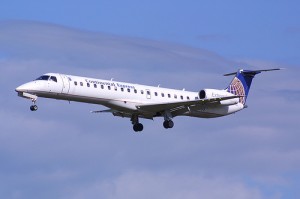
Continental Airlines ERJ-145 -- First time I will get to fly this aircraft type!
I am once again sitting at Seattle-Tacoma International Airport. This time, I am on my way to Mazatlan, Mexico for some much needed R&R. This means I will not be too active on the blog during this next week, but there will still be at least something posting once per day.
Knowing me, I will try my hardest to get to the internet and see what is going on and still blog (I love this stuff). But with working a full time job and running the blog (lots of work behind the scenes too), I really can use the vacation ;).
I am flying out on Continental Airlines and I am excited since this will be the first time I will ride an ERJ-145. Also, this might be the last time I get free food on a Continental flight to boot!
Actually set off the metal detector (forgot to take out my iPhone — oops). I was a little nervous since I have my AirlineReporter.com tags on my bags and did a pretty critical blog on the TSA yesterday — didn’t want to get a full pat-down (and luckily didn’t get one).
Don’t worry, you will get a full report once I return. Anyone know any good aviation related stuff near Mazatlan?
connect | web | twitter | facebook |
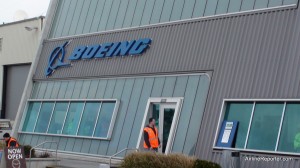
Boeing facility at Paine Field. Photo taken by me during my Boeing 787 interior tour.
When the Boeing’s 787 Dreamliner first took flight back in December 2009, there were those who questioned if Boeing really missed out on a customer relations opportunity.
Yes, Boeing had a live video feed on the internet and posted some wonderful photos and videos on their special newairplane.com website, but it still left some wanting more. People questioned why weren’t they on Twitter? Why didn’t they provide more for those that love Boeing? I somewhat agreed and felt that Boeing was making an effort, but was still distant from their fan base.
However, I think things are changing.
I have always been a frequent visitor to boeing.com, however I have been very impressed with their newer website newairplane.com. It isn’t just dry information that airlines or engineers might be interested in, but something that can really build passion for the Boeing brand. You can check out what new liveries will be on the Boeing 787 Dreamliner, take a virtual tour of both the Boeing 787 or the Boeing 747, find lots of great multimedia, and much more. It looks like I am not the only fan. Bernard Choi, with Boeing Communications, tells me that newairplane.com gets about 5-6million page views each month. That alone is a great indication, people want a closer relationship to Boeing.
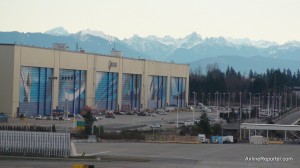
Boeing facility at Paine Field where the Boeing 767, 777, 747 and 787 are made.
Boeing has also stepped into the world of Twitter. They now have three accounts: @BoeingAirplanes, @BoeingCorporate, and @BoeingDefense. And really, they are doing an outstanding job, especially only being on it for about two weeks. This week, they had their first real test of social media and I think they passed.
John Windsor, who specializes in marketing and advertisement, blogged that his son sent a photo to Boeing of a new airplane with a pretty cold response. Boeing sent a canned reply stating they do not take any outside ideas and have destroyed his son’s information. Of course this is a form letter sent to anyone who submits an idea and they didn’t have a specialized form letter to reply to a child. Honestly, it made Boeing look like it has no compassion.
A few people Tweeted the blog and it got to Boeing. Boeing Tweeted, “The letter Mr. Winsor posted is, as he said, a required response. For kids, we can do better. We’ll work on it.” Cool. They could have defended their actions, but admit that it was not appropriate and they want to improve the way they do things.
Also, Boeing Corporate Communications director Todd Blecher, also made a comment on Mr. Windsor’s blog:
“Mr. Winsor…I think I can address your comments. As you state, we have to respond to the thousands of unsolicited ideas we receive in a way that protects us against possible infringement claims. Having said that, we can do better when the idea clearly comes from a child as enthusiastic as your son. We will work on this. I hope Harry remains fascinated by airplanes and grows up to be an airplane designer. To help him and others like him we maintain the following website. I hope he enjoys it.”
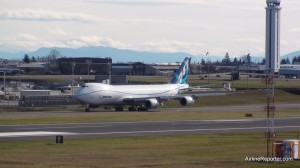
The Boeing 747-8 during taxi testing at Paine Field before its first flight.
To me, that is quite awesome. He made his comment right after I made mine and I like to think I am quite quick. With all the changes and this Twitter incident, I started to wonder if Boeing was trying to directly interact with customers more than they have in the past.
I decided to try and find out. I wrote to a few folks at Boeing and heard back from Todd Blecher (remember he is the Boeing Corporate Communications director that made the blog comment) very quickly. I asked if Boeing was consciously making an effort to connect better and how they were going to respond to Mr. Winsor’s son, Harry.
Blecher assured me that Boeing will be sending Harry some items and he actually spoke with him on the phone, thanking him for his drawing and he hopes when Harry grows up, he will design airplanes for Boeing.
He also confirmed my hunches that Boeing is making a real effort here. “We spent much of the past 12 months developing and now executing an approach to online communications that makes sense for Boeing and our audiences. We figured out what we could bring to the table and how we would be willing to engage. We drew inspiration from many areas, including Randy’s Journal, newairplane.com, our corporate advertising, and other organizations.”
They realize they are new to this game and the transition won’t happen overnight. “We are learning as we go but I have no doubt that are on a journey that will see us really change the way Boeing communicates…the bottom line is we’re changing.” When I asked Blecher about their future plans he told me they are looking at Facebook, thinking about a future mobile app and possibly even a Boeing TweetUp (where people on Twitter get together, ie Aviation Geekfest). Boeing talking about a TweetUp? That’s amazing.
Blecher realizes they might not make everyone happy. “Not everybody in our audiences will like our approach. But, to paraphrase Sinatra, we’re doing it our way because to try it any other way, to expect an organizational mindset to change overnight, is a sure way to set yourself up for a lot of frustration and aggravation and mistakes.” Even if they might make a few mistakes and frustrate a few people, I think it will be worth it in the long-run.
Who knows, if Boeing can really build that brand loyalty, maybe more people will be saying, “If it ain’t Boeing, I ain’t Going!”
connect | web | twitter | facebook |

Ben Gurion International Airport outside of Tel Aviv.
A few weeks ago I wrote a blog calling body scanners a “joke” and I was quite harsh on the Transportation Security Administration’s (TSA) decision to move forward with them.
Don’t get me wrong. I fly a lot. I like my life. I am all about protecting it and those who fly with me. But, I am not about the TSA wasting money for “security theater.”
After I posted my thoughts, the TSA posted a blog titled, “Advanced Imaging Technology – Yes, It’s Worth It.” It seem to be a rebuttal to those of us who have voiced concern about the TSA moving forward with the body scanners. However, TSA’s explanation is short on actual specifics of how the body scanners will stop someone from doing harm to airlines and passengers.
In my previous blog, my biggest issue was people could choose to avoid the scanners. If you didn’t want to be scanned, you could opt to get a pat down. For privacy reasons, it is great they offer this alternative, but for safety reasons it makes no sense. Why use all this pricey equipment, if someone who wants to do harm can just avoid it?
Their blog does a wonderful job explaining how these high-tech body scanners can pick up the smallest illegal items, but nothing about how scanners can be avoided or steps that are being taken to stop more privacy violations. I posted the question directly to the folks at TSA Blog, but never got a response, even though they did answer other people’s questions.
Over on my Seattle PI syndication I currently have 45 comments from readers who feel strongly (on both sides) about the body scanners. This shows me there are quite a few other people out there that have grave concerns about these scanners. I have been told a few times, “okay smart guy, how about stop just complaining and provide a solution” (okay, maybe not exactly like that, but you get the idea).
I would really hope someone out there with experience in air safety, could find a better solution. Talking to people about airport security I kept being told to check out out how Israel works their airport and airline security. So, I did and what I found looks like they might be on to something.
Isreal’s security allows for greater security, but less inconvience for travellers. And it must work. Tel Aviv’s Ben Gurion Airport, Israel’s larget hub, has not had a security breach since 2002.
“It is mindboggling for us Israelis to look at what happens in North America, because we went through this 50 years ago,” said Rafi Sela, the president of AR Challenges, a global transportation security consultancy, in an interview with TheStar.com. He’s worked with the RCMP, the U.S. Navy Seals and airports around the world. “Israelis, unlike Canadians and Americans, don’t take shit from anybody. When the security agency in Israel (the ISA) started to tighten security and we had to wait in line for not for hours but 30 or 40 minutes, all hell broke loose here. We said, ‘We’re not going to do this. You’re going to find a way that will take care of security without touching the efficiency of the airport.”
Their security is a multi-layer system:
LAYER 0: Intelligence
Before anyone even leaves for the airport, Isreal has strong intelligence network, trying to determine particular threats and dispose of them before they even reach the first layer.
LAYER 1: Roadside Check
Before you can even get to the airport, security stops every car and asks two questions, “How are you? Where are you coming from?” The answers aren’t nearly important, but more of how the person responds. Security officers are trained to detect nervousness and distress. Not the amount that a lot of people feel from flying, but those that occur when you are about ready to kill yourself and many others.
LAYER 2: Outside Guards
Armed guards are stationed outside the terminal and are trained to observe passengers. Any sort of odd behavior or strange baggage, you will be pulled aside for additional questioning and possible searches.
LAYER 3: Bag Inspections
Passengers that look suspicious or are just random will be pulled aside to be scanned by a metal detector and have their bags scanned.
LAYER 4: Ticket Agent Questions
Now, you have fully made it into the terminal. The ticket agent will take your documents and ask you a series of questions, the whole time, looking directly into your eyes, “which is very embarrassing. But this is one of the ways they figure out if you are suspicious or not. It takes 20, 25 seconds,” said Sela. Again, they are specially trained to detect body language that would show the person means to do harm. Also, passengers are not allowed to group up, which would provide a group target for a terrorist.
LAYER 5: Bag Termination
Let’s say a terrorist has made it through the first four layers of security and still is able to get his bomb to the ticket agent. Every bag is screened right away. If a bomb or suspicious material is found, they do not evacuate the whole terminal, like you would see in America. Evacuation causes panic, more targets, and a huge delay. Instead, scanners have bomb boxes near by and a suspected bag is put into the box, which can contain an explosion of up to 100 kilos of plastic explosives. People within a few meters of the suspected bomb need to be cleared and the rest of the airport is able to go through its normal business. “This is a very small simple example of how we can simply stop a problem that would cripple one of your airports,” Sela said.
LAYER 6: Body and Luggage Check
You would think this is like America’s security check, but Sela says, “Here it is done completely, absolutely 180 degrees differently than it is done in North America. First, it’s fast there’s almost no line. That’s because they’re not looking for liquids, they’re not looking at your shoes. They’re not looking for everything they look for in North America. They just look at you.”
All these layers have solid security, but they also get passengers from the parking lot to their gate in less than 25 minutes. Now, that is impressive. Sela feels the TSA could move in this direction, but they are on the wrong path. “Even today with the heightened security in North America, they will check your items to death. But they will never look at you, at how you behave. They will never look into your eyes … and that’s how you figure out the bad guys from the good guys.”
Yes, this is profiling, but I think it is the good kind of profiling. Racial profiling = wrong, behavior profiling = right. Sela said, “To us, it doesn’t matter if he’s black, white, young or old. It’s just his behaviour. So what kind of privacy am I really stepping on when I’m doing this?”
Do the Israelis have a good security system? I think so, but I don’t think it could easily be used the exact same way in America. We definitely don’t do well with seeing people with large guns walking around and this system would be vulnerable to racial profiling. I do think looking at behavior profiling would be a better use of resources than spending money on machines that people can skip all together.
Sources: TheStar.com & Vancouver Sun Image: iamxande
connect | web | twitter | facebook |
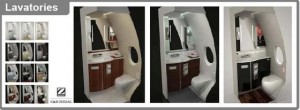
Some of the Airbus A350 lavatory options. Click the link to RunwayGirl's blog for larger version.
Now that the Boeing 787 and Boeing 747-8 have taken their first flights, attention is starting to move towards watching the new Airbus A350. Mary Kirby, over on her blog RunwayGirl, is posting a glimpse of the interior of the new Airbus A350.
Airbus has been working on the Aircraft Description Document, defining what interior options will be available. With the A350, Airbus hopes to increase flexibility in cabin layout, without having to change the structure of the aircraft.
The Airbus A350 is Airbus’ answer to the Boeing 787 (and partially to the B777). Like the Boeing 787, it will be made primarily of carbon fiber and be more fuel efficient compared to previous aircraft types. Currently the A350-900XWB is expected to carry more passengers and fly farther than the Boeing 787-8. The first flight is currently scheduled for 2012, with delivery scheduled for 2013.
Check our RunwayGirl’s blog for more photos and information on the Airbus A350 interior.
And if you are on Twitter, we made #A350XWP the official hashtag for the Airbus A350 (if that makes no sense to you, don’t worry about it).
connect | web | twitter | facebook |
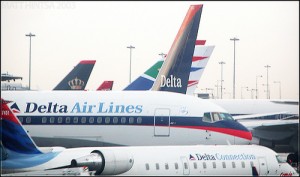
Bunch of traffic at New York's JFK Airport.
Be careful what you ask for…
I am sure you have heard on the news about passengers being stuck in planes for hours and hours with little food and water. Is that a fun experience? Heck no.
When I was a teenager I was stuck on the tarmac for over five hours and it was not a pleasant experience. However, after the five hours I got to fly home to my family. My flight was from Seattle, WA to Reno, NV and we had to be diverted to San Jose, CA due to poor weather. With the new rules going into affect in two days, I could have been stuck at an unfamiliar airport, with no family and no real money.
Over the past few years, quite a few airlines have made the news for leaving passengers stuck on the runway for hours; passengers got angry. Some passengers got REALLY angry. They wanted the government to step in and make sure no other passenger had to be stuck on the tarmac for long periods of time again.
To me, being stuck on the plane was not a fun experience, but it is life, it happens. No matter the form of transportation I would have used, the end result would have been the same — delayed due to the weather.
The new rules, starting April 29th, state that an airline will have to allow passengers to disembark if they have been sitting on the tarmac for three hours, unless doing so would jeopardize safety. The new rule sounds like a pretty good deal for passengers in theory, but in reality, I think it will cause a lot more frustration, loss of money and even more angry passengers.
With the new rules, an airline can be charge up to $27,500.00 per passenger that is left on an airplane for more than three hours. That is a lot of money. If an airline sees that a flight might be delayed for three hours, instead of waiting, they might just cancel the flight. This doesn’t mean that the plane will just sit around waiting. That plane needs to be at the next destination. It might have to fly empty to pick up the next set of passengers. If it doesn’t, routes all over will be delayed and even more passengers will be upset and more revenue will be lost.
That leaves the question: Would you rather be stuck on a plane for four hours and reach your destination? Or would you rather be stuck in a city, sleeping in the airport for much longer…possibly days?
What’s worse is New York’s JFK airport is already known for their long delays. Right now their main runway is closed for some improvements. Because of this, some airlines have asked for an exception from the three hour rule, but they were denied. Remind me not to fly out of JFK for the next few weeks!
Again, this is another time where the government should not be interfering with the airlines. Already airlines get a bad rap if they leave passengers in the airplane for hours. The mainstream media loves to bash them.
The airline business is extremely complicated and that is when things go right. Throw in bad weather, aircraft issues, scheduling problems, huge pressure for the lowest prices, and security and you have a business just waiting for things to go wrong.
For me, I would rather be stuck on an airplane going no where for a few hours, than not being able to reach my destination. I can easily survive a few hours without food and water and waiting inside an airplane is a heck of a lot better than trying to take a bus.
Image: matt.hintsa
connect | web | twitter | facebook |






